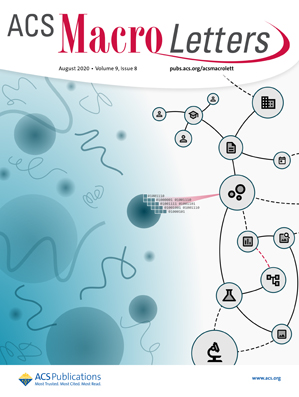Engineering the Water/Salt Sorption Selectivity of Polymers for Desalination Applications.
IF 5.2
Q1 POLYMER SCIENCE
引用次数: 0
Abstract
In this paper, we report two synthetic strategies to engineer the water/salt sorption selectivity of polymers: tethering polar functional groups to the polymer backbone and increasing the degree of cross-linking. For the first strategy, we found that at a given water content, the dielectric constant of hydrated methacrylate-based polymers functionalized with hydroxyethyl (i.e., two carbon) side chains (XL - p(HEMA-co-GMA) is less than that of hydrated methacrylate-based polymers with hydroxypropyl (i.e., three carbon) side chains (XL - p(HPMA-co-GMA), which contributes to suppressing salt sorption to increase the water/salt sorption selectivity. For the second strategy, we found that forming densely cross-linked polymers that contained only dimethacrylate-based monomers (XLPEGDMA) relative to less densely cross-linked copolymers containing both methacrylate- and dimethacrylate-based comonomers (XL - p(HEMA)) reduced the network mesh size at a given water content, which also suppressed salt sorption and increased the water/salt sorption selectivity. These structure-property results inform the design of advanced materials for desalination membrane applications.设计用于海水淡化的聚合物的水/盐吸附选择性。
在本文中,我们报告了两种合成策略来设计聚合物的水/盐吸附选择性:将极性官能团系在聚合物主链上和增加交联度。对于第一种策略,我们发现在一定含水量下,水合甲基丙烯酸酯基羟乙基(即二碳)侧链聚合物的介电常数(XL - p(HEMA-co-GMA))小于水合甲基丙烯酸酯基羟丙基(即三碳)侧链聚合物的介电常数(XL - p(HPMA-co-GMA)),这有助于抑制盐的吸附,从而提高水/盐的吸附选择性。对于第二种策略,我们发现形成仅含有二甲丙烯酸酯基单体(XLPEGDMA)的密集交联聚合物相对于含有甲基丙烯酸酯和二甲丙烯酸酯基单体(XL - p(HEMA))的密度较小的交联共聚物在给定含水量下减小了网状尺寸,这也抑制了盐的吸附并增加了水/盐的吸附选择性。这些结构-性能结果为海水淡化膜应用的先进材料的设计提供了信息。
本文章由计算机程序翻译,如有差异,请以英文原文为准。
求助全文
约1分钟内获得全文
求助全文
来源期刊
CiteScore
10.40
自引率
3.40%
发文量
209
审稿时长
1 months
期刊介绍:
ACS Macro Letters publishes research in all areas of contemporary soft matter science in which macromolecules play a key role, including nanotechnology, self-assembly, supramolecular chemistry, biomaterials, energy generation and storage, and renewable/sustainable materials. Submissions to ACS Macro Letters should justify clearly the rapid disclosure of the key elements of the study. The scope of the journal includes high-impact research of broad interest in all areas of polymer science and engineering, including cross-disciplinary research that interfaces with polymer science.
With the launch of ACS Macro Letters, all Communications that were formerly published in Macromolecules and Biomacromolecules will be published as Letters in ACS Macro Letters.

 求助内容:
求助内容: 应助结果提醒方式:
应助结果提醒方式:


